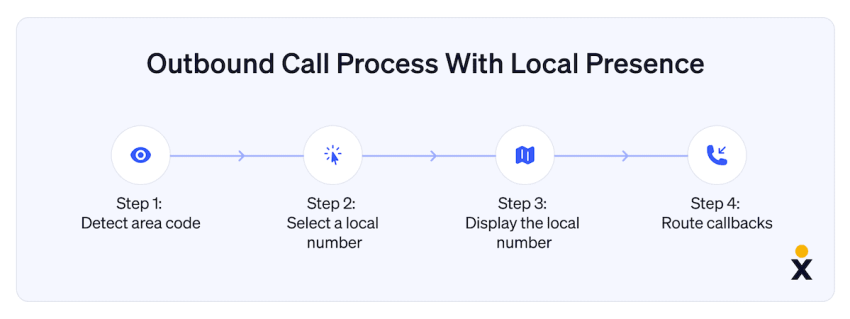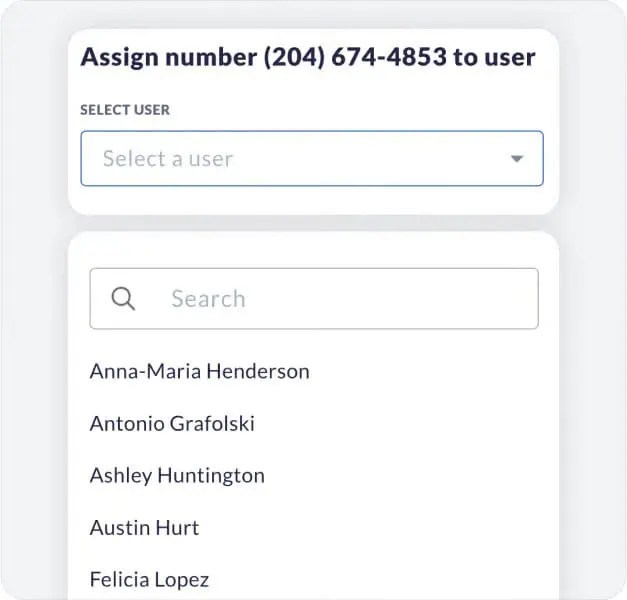Your phone rings, and it’s an unknown number. You know there’s a high possibility it’s a spam call. If you know this, you can be sure the people you’re tasked with calling are aware of this, too.
In a spam-heavy calling environment, you need all the tools and tactics available to improve answer rate. One of those tools is called local presence dialing. And it might just change the face of your sales efforts.
What Is a Local Presence Dialer?
A local presence dialer is a VoIP feature that assigns a local area code to outbound calls, matching the recipient’s location. For example, when you call a contact in the New York area, you can display a 212, 646, 332, 718, 347, 917, or 929 area code — regardless of where your business is located.

Businesses use a local presence dialer to create a familiar, trusted caller ID for the recipient. It’s generally accepted, and numerous studies have shown that presenting a local area code — or simply presenting any code rather than a blocked number — leads to contacts answering calls more frequently.
Local presence dialers are typically used in cold calling, outbound sales, and follow-up outreach. However, there are also niche use cases across different industries.
How it works
Local presence dialing works using four key steps to improve answer and callback rates:
- When you initiate a call, the sales dialer detects the recipient’s area code.
- The dialer automatically selects a local presence number from a pool of available business phone numbers.
- The outbound call appears as a local number on the recipient’s device.
- If the prospect calls back, it routes intelligently to the original rep or follow-up workflow.

Benefits of Local Presence Dialing
Increased pickup rates
People are more likely to answer phone calls from a number they recognize or associate with their region. In fact, people are 20.5% more likely to answer a call from a local area code than a withheld number.

Further studies show that local numbers can boost answer rates by up to 27.5% compared to toll-free or out-of-state numbers.
Improved callback opportunities
The simple addition of a local area code encourages recipients to return missed calls, whereas unknown numbers often go ignored. Think about the last time you received a missed call on your cell. There is no physical method of returning a call to an unknown number. And, if you don’t know anyone in the region of an out-of-town call, you probably didn’t return it. Out-of-region or international numbers may also be seen as spam or too expensive to return.
However, a local presence call stands a higher chance of recipients returning a missed call. After all, it could be a family member, a local business, or something relevant to your location.
Better lead engagement for sales reps
Most commonly used in sales environments, local presence dialers mean more connects. More connects mean more opportunities to qualify, nurture, and close deals.
Local caller ID builds early trust, giving reps a stronger starting point. The simple addition of a caller ID — better yet, a local caller ID — starts calls off on a positive note rather than a suspicious one.

There’s less “Who’s calling me from out of town?” and more answered calls because they’re familiar area codes. From here, sales agents have an advantage when calls get answered. You can establish a connection and proceed with your value proposition.
Cost-efficient regional expansion
You don’t need to move to a specific area for it to become your target market. Instead, you can launch into new geographic markets without the need for physical offices or regional teams. Previously, you needed to be based in a certain region to gain access to that local area code. Today, local presence dialing removes that requirement.

This is not only useful for regional expansion but also for remote-first teams or distributed sales organizations targeting multiple states or countries. There’s no need for regional offices targeting each set of contacts. Every agent has automated local presence dialing so they can make contact with all your prospects from the comfort of their living room (if they so desire).
Higher efficiency in call campaigns
It’s no secret that the best use of sales reps’ time is talking to prospects and customers. Therefore, reducing voicemails, hang-ups, and ignored calls is important.
Using local presence dialing not only improves answer rates and allows agents more time with customers, but when combined with CRM systems and automation tools, it ensures context-rich, follow-up-ready conversations.
When you do everything in your power to optimize answering and callback rates, sales reps come into their own.
Local Presence Dialing vs. Caller ID Spoofing
You may be thinking that local presence dialing sounds somewhat like caller ID spoofing. There is a similarity in that you’re presenting a different number/area code than your physical location. However, there are some major differences to be aware of, too.
Local presence dialing is legal and ethical. You own or rent the numbers from your VoIP provider. Caller ID spoofing, on the other hand, uses fake or unauthorized numbers that are often associated with spam and can be illegal.
For a positive caller ID reputation, local presence dialing provides a superior experience and higher answer and callback rates. Spoofing may increase failing answer rates, but it isn’t a sustainable model for high response.
Nextiva ensures phone and contact center compliance by assigning verified local presence numbers that adhere to regional and federal dialing laws. Caller ID spoofing doesn’t look after this.
| Aspect | Local Presence Dialing | Caller ID Spoofing |
|---|---|---|
| Legal Status | Legal and ethical business practice. | Illegal when done with the intent to defraud, cause harm, or wrongfully obtain anything of value. |
| Number Ownership | Uses phone numbers owned or rented from legitimate VoIP providers. | Uses fake, unauthorized, or stolen numbers without proper ownership rights. |
| Purpose | Legitimate business communication to increase call answer rates. | Often used for fraudulent activities, scams, and deceptive practices. |
| Association With Spam | Not inherently associated with spam when used properly. | Heavily associated with spam calls, robocalls, and fraudulent schemes. |
| Call Answer Rates | Increases answer rates significantly for local numbers. | May initially increase answer rates but can damage long-term trust and reputation. |
| Caller ID Reputation | Maintains a positive caller ID reputation when used responsibly. | Severely damages the caller ID reputation and can result in numbers being flagged as spam. |
| Compliance Requirements | Must comply with regional and federal dialing laws and requires verified number assignments. | Violates federal telecommunications regulations and can result in significant penalties. |
| Business Ethics | Considered an ethical business practice for legitimate outreach. | Considered an unethical and deceptive practice. |
| Implementation Method | Implemented through legitimate phone systems with purchased number pools. | Implemented through VoIP spoofing, spoofing services, or other unauthorized techniques. |
| Regulatory Oversight | Subject to FCC numbering authorization processes and state commission requirements. | Prohibited under federal telecommunications laws, with enforcement actions. |
| Consumer Trust | Builds trust through local presence and legitimate business identification. | Destroys consumer trust and contributes to call screening behaviors. |
| Long-term Viability | Sustainable business practice with proper compliance measures. | Unsustainable due to legal risks and reputation damage. |
Core Features of a Local Presence Dialer
When considering a local presence dialer, make sure to look for the following features as standard.
| Feature | Description |
| Automatic Area Code Matching | Detects the recipient’s area code and assigns the nearest local number. |
| Callback Routing | Ensures return calls go to the rep who originally placed the call or a designated queue. |
| CRM Integration | Works with Salesforce, HubSpot, and others to log call details and trigger workflows. |
| Multiple Number Pools | Choose from bundles of 100+ local numbers to cover most U.S. metro areas. |
| Voicemail and Missed Call Automation | Trigger automatic follow-ups or SMS when sales calls go unanswered. |
| Campaign Reporting | Monitor pickup rates, routing patterns, and rep performance through dashboards. |
Best Practices for Using Local Presence Dialing
When adopting local presence dialing for the first time, consider the following:
- Train your sales reps to identify and handle callbacks professionally: Recognize a callback as the unexpected gold of sales prospecting: Routing to the correct agent and empowering them with a localized/personalized script is crucial for turning callbacks into appointments or sales.
- Use automation to schedule retries or voicemails for missed calls to local presence numbers: Just because your prospect didn’t answer the first time, it doesn’t mean they won’t answer when they’re not busy, especially when it’s a local number.
- Combine with an auto dialer, like a power dialer, to maximize call volume with smart local area code logic: The more you automate dialing, the less manual work for sales reps and admins. They can dedicate more time to building relationships and selling products.
- Test different geographies and number pools to identify which local codes yield the best results: Sometimes, the application of any local number (rather than a blocked number) is all you need. Other times, you may need to be uber-specific to the prospects’ locale.
- Stay compliant with FCC, STIR/SHAKEN, and DNC guidelines, especially for outbound campaigns: If you stray from industry guidelines, all your hard work will be for nothing.

Who Should Use a Local Presence Dialer?
Any business that engages with sales prospects in local areas different from their own can benefit from using local presence dialing.
- Small businesses: Expanding into new states without local branches.
- Enterprise sales teams: Operating across national or global territories.
- Outbound call centers: Managing high-volume outreach campaigns.
- Real estate, insurance, and financial services firms: Looking to establish a neighborhood feel.
- B2B SaaS providers: Targeting segmented territories via SDR/AE teams.
For a Local Presence, Choose Nextiva
Whether you’re building your first outbound campaign or scaling across regions, Nextiva’s local presence dialer feature, integrated into our VoIP phone system and AI-powered contact center platform, delivers high-converting, trust-building conversations.
Nextiva’s platform makes local presence dialing simple, scalable, and smart:
- AI-powered call routing that ensures callbacks get to the right person.
- Access to a nationwide pool of verified local phone numbers.
- CRM-ready integrations that keep sales and support teams aligned.
- Unified VoIP and contact center platform with built-in dialing — no third-party plugins or workarounds.
- Transparent pricing with no hidden fees for local presence bundles.
- 24/7 customer support to troubleshoot, optimize, and scale with your team.

So, if your campaigns don’t have the high answer and callback rates you crave, see how Nextiva’s local presence dialing can improve answer rates and increase agent productivity.
Get local phone numbers in any area code.
Build trust and establish a local presence with a local business phone number. Easy to set up and use. Trusted by millions.

















 Business Communication
Business Communication 










